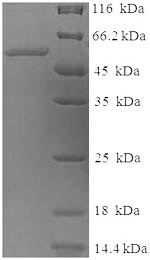The DNA sequence coding for 19-377aa of human Tyrosinase (TYR) was used to express recombinant TYR protein in the E.coli cells. The recombinant TYR protein was fused with a 6xHis-SUMO-tag at the N-terminus. According to the SDS-PAGE analysis, a molecular mass band of about 57 kDa of the TYR protein was visualized on the gel. The purity of this TYR protein is greater than 90%. This recombinant partial TYR protein may be used to produce specific anti-TYR antibodies or in the studies of TYR-mediated metabolism.
TYR is a copper-containing metalloenzyme responsible for the melanogenesis in mammals and enzymatic browning in the fruit and vegetables. It possesses both monophenolase activity and diphenolase activity. Inhibitors of TYR are attractive to act as depigmentation agents in cosmetics and medicinal industries and antibrowning compounds in the food and agriculture industries.






